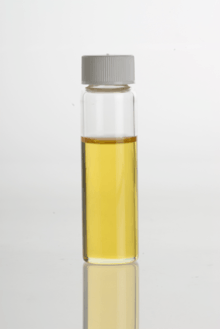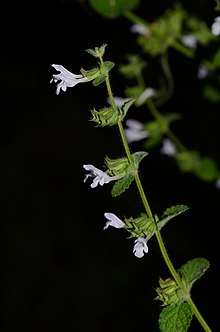Lemon balm
| Lemon balm | |
|---|---|
.jpg) | |
| Scientific classification | |
| Kingdom: | Plantae |
| Clade: | Angiosperms |
| Clade: | Eudicots |
| Clade: | Asterids |
| Order: | Lamiales |
| Family: | Lamiaceae |
| Genus: | Melissa |
| Species: | M. officinalis |
| Binomial name | |
| Melissa officinalis | |
Lemon balm (Melissa officinalis),[1] balm,[2] common balm,[3] or balm mint, is a perennial herbaceous plant in the mint family Lamiaceae and native to south-central Europe, the Mediterranean Basin, Iran, and Central Asia, but now naturalized in the Americas and elsewhere.[4]
It grows to a maximum height of 70–150 cm (28–59 in). The leaves have a mild lemon scent similar to mint. During summer, small white flowers full of nectar appear. It is not to be confused with bee balm (genus Monarda), although the white flowers attract bees, hence the genus Melissa (Greek for "honey bee").
The leaves are used as a herb, in teas, and also as a flavouring. The plant is used to attract bees for honey production. It is grown as an ornamental plant and for its oil (to use in perfumery). The tea of lemon balm, the essential oil, and the extract are used in traditional and alternative medicine, including aromatherapy. The plant has been cultivated at least since the 16th century, but research is still being conducted to establish the safety and effects of lemon balm.
Uses
The plant is used to attract bees to make honey. It is also grown and sold as an ornamental plant. The essential oil is used as a perfume ingredient,[5] but the plant has other culinary and medicinal uses. Lemon balm is used in some toothpastes.[6]
Culinary
Lemon balm is used as a flavouring[5] in ice cream and herbal teas, both hot and iced, often in combination with other herbs such as spearmint. It is a common addition to peppermint tea, mostly because of its complementing flavor.
Lemon balm is also paired with fruit dishes or candies. Additionally, it can be used in fish dishes and is the main ingredient in lemon balm pesto.[7]:15–16 Its flavour comes from citronellal (24%), geranial (16%), linalyl acetate (12%) and caryophyllene (12%).
It is also one of the ingredients in Spreewald gherkins.[8]
Traditional medicine

In traditional Austrian medicine, M. officinalis leaves have been prescribed for internal use—as a tea—or external application—as an essential oil—for the treatment of disorders of the gastrointestinal tract, nervous system, liver, and bile.[9] Lemon balm is the main ingredient of Carmelite water, which is still for sale in German pharmacies.[10]
In alternative medicine it is used as a sleep aid and digestive aid.[11]
Lemon balm essential oil is popular in aromatherapy.[12] The essential oil is commonly co-distilled with lemon oil, citronella oil or other oils.
Cultivation
M. officinalis is native to Europe, central Asia and Iran, but is now naturalized around the world.[7][13]
Lemon balm seeds require light and at least 20 °C (70 °F) to germinate. Lemon balm grows in clumps and spreads vegetatively, as well as by seed. In mild temperate zones, the stems of the plant die off at the start of the winter, but shoot up again in spring. Lemon balm grows vigorously; it should not be planted where it will spread into other plantings.
M. officinalis may be the "honey-leaf" (μελισσόφυλλον) mentioned by Theophrastus.[14] It was in the herbal garden of John Gerard, 1596.[15]
As of 1992 the major producing countries were Hungary, Egypt, Italy for herb, Ireland for essential oil.[16]
Cultivars
The many cultivars of M. officinalis include:
- M. officinalis 'Citronella'
- M. officinalis 'Lemonella'
- M. officinalis 'Quedlinburger'
- M. officinalis 'Lime'
- M. officinalis 'Variegata'
- M. officinalis 'Aurea'
- M. officinalis 'Quedlinburger Niederliegende' is an improved variety bred for high essential oil content
Medical research
The composition and pharmacology and potential uses of lemon balm have been extensively studied, especially with regard to its traditional uses.[17] Randomized, double-blinded clinical studies in people, however, have been limited and have had few subjects. Those studies cannot be used for generalized conclusions about the safety or efficacy of lemon balm and its components; what doses are safe and effective is especially not clear.[17]
Chemistry
Lemon balm contains eugenol, tannins, and terpenes.[18] It also contains (+)-citronellal, 1-octen-3-ol, 10-α-cadinol, 3-octanol, 3-octanone, α-cubebene, α-humulene, β-bourbonene, caffeic acid, caryophyllene, caryophyllene oxide, catechin, chlorogenic acid, cis-3-hexenol, cis-ocimene, citral A, citral B, copaene, δ-cadinene, eugenyl acetate, γ-cadinene, geranial, geraniol, geranyl acetate, germacrene D, isogeranial, linalool, luteolin-7-glucoside, methylheptenone, neral, nerol, octyl benzoate, oleanolic acid, pomolic acid ((1R)-hydroxyursolic acid), protocatechuic acid, rhamnazin, rosmarinic acid, stachyose, succinic acid, thymol, trans-ocimene and ursolic acid.[19][20] Lemon balm may contain traces of harmine.[21]
Rosmarinic acid appears to be the most important active component, but the interaction of chemicals within lemon balm, and with chemicals in other herbs with which it has been commonly used in traditional medicines, is poorly understood.[17] Lemon balm leaf contains roughly 36.5 ± 0.8 mg rosmarinic acid per gram.[22]
Gallery
 Sketch of leaves and flowers
Sketch of leaves and flowers Leaves
Leaves Leaves
Leaves- Leaves
- Plant
 Flowers
Flowers-flower-Vis-UV-IR-comparison.jpg) Spectral comparison showing nectar guide visible in UV
Spectral comparison showing nectar guide visible in UV- Lemon balm leaves in the UBC Botanical Garden
References
- ↑ "Lemon balm". University of Maryland Medical Center. Apr 5, 2011. Retrieved Oct 18, 2014.
- ↑

- ↑ "Melissa officinalis". Natural Resources Conservation Service PLANTS Database. USDA. Retrieved 6 July 2015.
- ↑ Kewe World Checklist of Selected Plant Families
- 1 2 "Taxon: Melissa officinalis L.". USDA: U.S. National Plant Germplasm System. Retrieved 8 October 2016.
- ↑ Dousti, Mashta; et al. (2012). "Evidence-based Traditional Persian Medicine". In Rastogi, Sanjeev; Chiappelli, Francesco; Ramchandani, Manisha Harish; Singh, Ram Harsh. Evidence-based practice in complementary and alternative medicine : perspectives, protocols, problems, and potential in Ayurveda. Berlin: Springer. p. 88. ISBN 9783642245640.
- 1 2 Herb Society of America. 2007 Lemon Balm: An Herb Society of America Guide Archived 2015-02-18 at the Wayback Machine.
- ↑ https://en.wikipedia.org/wiki/Spreewald_gherkins
- ↑ Vogl, S; Picker, P; Mihaly-Bison, J; Fakhrudin, N; Atanasov, AG; Heiss, EH; Wawrosch, C; Reznicek, G; et al. (2013). "Ethnopharmacological in vitro studies on Austria's folk medicine-An unexplored lore in vitro anti-inflammatory activities of 71 Austrian traditional herbal drugs". Journal of Ethnopharmacology. 149 (3): 750–71. doi:10.1016/j.jep.2013.06.007. PMC 3791396. PMID 23770053.
- ↑ Hiller, Sabine (September 6, 2010). "FOOD Using lemon balm in the kitchen". The Mayo News. Retrieved May 2, 2012.
- ↑ "Monograph: Lemon Balm". Health Canada. 17 March 2008. Retrieved 8 October 2016.
- ↑ Masters, Susanne (22 February 2013). "The benefits of lemon balm". The Guardian.
- ↑ United States Department of Agriculture, "PLANTS Profile for Melissa officinalis," http://plants.usda.gov/java/profile?symbol=MEOF2. Retrieved July 2, 2010.
- ↑ Theophrastus, Enquiry into Plants, VI.1.4, identified as "M. officinalis" in the index of the Loeb Classical Library edition by Arthur F. Hort, 1916 etc.
- ↑ As "Melissa" (Common Blam) in both issues of Gerard's Catalogus, 1596, 1599: Benjamin Daydon Jackson, A catalogue of plants cultivated in the garden of John Gerard, in the years 1596–1599, 1876;
- ↑ Axtell, B.L.; Fairman, R.M (1992). "Melissa officinalis". Minor oil crops. Rome: Food and Agriculture Organization of the United Nations. ISBN 92-5-103128-2.
- 1 2 3 Shakeri, Abolfazl; Sahebkar, Amirhossein; Javadi, Behjat (2016). "Melissa officinalis L. – A review of its traditional uses, phytochemistry and pharmacology". Journal of Ethnopharmacology. 188: 204–228. doi:10.1016/j.jep.2016.05.010. PMID 27167460.
- ↑ Ehrlich, Steven D. (January 2, 2015). "Lemon balm". University of Maryland Medical Center. Retrieved June 23, 2017.
- ↑ "Feature extracts – Melissa officinalis". naturalcompounds.com. 2012. Archived from the original on March 10, 2016. Retrieved December 24, 2013.
- ↑ Taylor, Leslie (December 17, 2012). "Lemon Balm (Melissa officinalis)". Tropical Plant Database (rain-tree.com). Leslie Taylor. Retrieved June 23, 2017.
- ↑ Harrington, Natalie (2012). "Harmala Alkaloids as Bee Signaling Chemicals". Journal of Student Research. 1 (1): 23–32.
- ↑ Shekarchi, Maryam; Hajimehdipoor, Homa; Saeidnia, Soodabeh; Gohari, Ahmad Reza; Hamedani, Morteza Pirali (2012). "Comparative study of rosmarinic acid content in some plants of Labiatae family". Pharmacognosy Magazine. 8 (29): 37–41. doi:10.4103/0973-1296.93316. PMC 3307200. PMID 22438661.
| Wikimedia Commons has media related to Melissa officinalis. |
| Wikiversity has bloom time data for Melissa officinalis on the Bloom Clock |
External links
- A Modern Herbal, 1931, by Maud Grieve. ISBN 0-486-22798-7, electronic version: Lemon Balm
- University of Maryland Complementary and Alternative Medicine Guide: Lemon Balm. Last reviewed 1/2/2015 by Steven D. Ehrlich, NMD